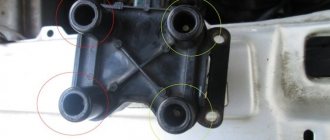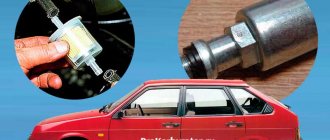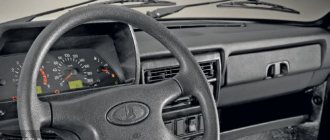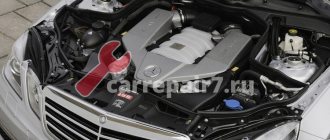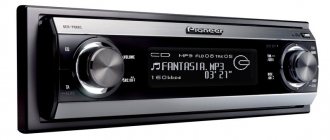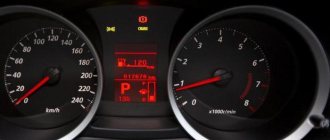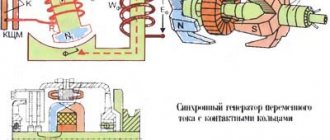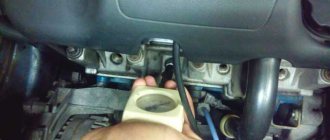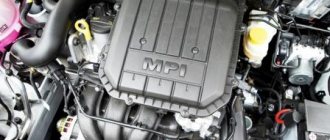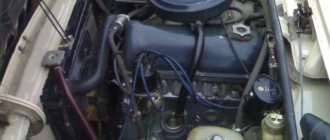A VAZ car stalls at idle quite often when there is a malfunction of sensors, components or parts. It is also possible that the car's lines, filters, and various elements in the system become contaminated.
If any of the VAZ models, including the Chevrolet Niva, stalls at idle, then first of all you should pay close attention to the quality of gasoline. Problems with starting or incorrect operation of the engine after the next refueling may arise precisely because of low-quality fuel. In this case, it is worth draining all the gasoline and changing the fuel filter.
When these steps do not help, you need to check the spark plugs in the car. The working part is distinguished by the light gray color of the central electrode. The carbon deposits on the candles should be light brown. In case of any deviations from the norm, we can assume that the part has failed. Replace the spark plugs and try to start the engine again.
A faulty ignition module can also cause problems with starting the engine. Knowledge of at least a minimum of electrical engineering will allow you to check its performance. But it is better to contact a specialized service.
A generator malfunction leads to a decrease in the bot network voltage. In this case, all vehicle systems are powered by the battery. This is also the reason why a car stalls at idle when hot. On the instrument panel indicators of some models you can see a decrease in the mains voltage. Here it is worth diagnosing the generator for the presence of a breakdown.
What are the reasons leading to incorrect engine operation:
- The throttle valve is broken or dirty.
- Contamination in the crankcase ventilation.
- Malfunction of the throttle position sensor or mass fuel flow sensor, other indicators.
- Faulty or clogged parts of the idle air regulator.
- Carburetor channels are clogged with sediment.
- Fuel nozzle clogged.
- Debris or errors in the operation of injection nozzles.
- Faulty or dirty fuel pump filter mesh.
- Fuel filter is dirty.
The engine does not idle: the main reason
The first thing you need to pay attention to is the solenoid valve. However, it is not installed on all VAZ 2106 carburetors. It is this small device that most often falls into disrepair. Its operating principle is similar to a solenoid relay - there are windings, an armature, and a return spring, but the dimensions are somewhat smaller.
The function of the solenoid valve is to open the path for gasoline to flow (with the throttle valve closed) when the ignition is turned on. And close when disconnected, respectively.
The most common breakdowns of the solenoid valve, as a result of which the idle speed disappears:
- The winding is destroyed, the armature with the needle does not move, fuel is not supplied.
- The fuel nozzle located on the edge of the valve is clogged.
- The valve armature is jammed due to deformation.
You can check this device very quickly; you will need a small piece of wire, stripped from both edges. Connect one end to the positive side of the battery, and connect the other end to the terminal of the solenoid valve. There should be a fairly loud click, but if it doesn’t, then most likely the winding is damaged.
If there is a click, remove the wire connected earlier and turn on the ignition. Place the power connector onto the valve. If there is no click, then the wiring is damaged. In the event of a breakdown, there can be three exits, you can use any:
- If the solenoid valve is completely destroyed, it would be wise to unscrew it and remove the tip (fuel nozzle). And thus get to the nearest store without much difficulty. The price of a new VAZ 2106 solenoid valve is about 100 rubles, so repairs will not be expensive.
- Temporarily connect the output of the solenoid valve to the positive terminal of the battery - if the wiring is damaged. But in this case you will have to remove the wire during each stop.
- It would be much more efficient to run a wire from the solenoid valve output to the “+B” ignition coil contact. The fact is that voltage appears on it only after the ignition is turned on.
Troubleshooting carburetor problems
Regardless of whether an EMC is installed or not, the procedure for cleaning the idle fuel jet is the same.
- Unscrew the plug holder or EMC.
- Unscrew and remove the fuel jet XX.
- Clean the central channel of the jet.
In order to remove the XX jet from the radiator body, you will need a 13-size wrench, but depending on the design, a 14-size wrench can also be used. After turning the EMC, remove the nozzle. If the center hole is clogged, carefully clean it with a thin wire or blow it out with compressed air.
Once the fuel jet center channel is clean, reinstall it. Screw in until it stops and tighten carefully with a wrench. Connect the “positive” wire to the power terminal of the EMC. Start the engine.
To make it easier to work with the carburetor, it is necessary to remove the air filter. Turn on the ignition, first removing the power wire from the EMC terminal. Touch the power wire to the valve terminal. A distinct click indicates that power is coming to the EMC input. In this case, the cause of the malfunction should be sought in the jet or in the carburetor itself. The absence of a click indicates that the fault is in the solenoid valve or fuse. To check the valve, connect the “plus” of the car battery to the terminal of the EMC, and the “minus” to its body. If there is no click, the solenoid valve is faulty and must be replaced.
If power does not come to the EMC input, the reason may be a faulty wiring or the need to replace an 8A fuse. If you have a standard fuse box, then this part is installed in the 9th cell.
If the fuse, wiring and the valve itself are in good condition, the reason for poor idling of the VAZ 2106 may be a clogged XX fuel nozzle. In this case, it must be cleaned.
The engine stops while running - reasons
1. Poor quality fuel is the first thing that comes to mind for most of us, and besides, this is where we need to start looking for the reason for the engine stopping while driving. You will be “lucky” if this happens immediately after refueling, in which case you can confidently say that the problem is in the fuel. Treated by draining the fuel and replacing the fuel filter.
2. Candles. As a rule, suspicion most often falls on them, after bad fuel, of course. Everything is simple here - unscrew the spark plugs and check their condition, replace the spark plugs if necessary.
Read more about why the engine vibrates at idle
The most common cause of engine vibration is, in fact, its tripling, that is, uneven operation of a group of cylinders. It is for this reason that the load on the crankshaft will likely be distributed unevenly, and the engine will begin to seem to move from side to side. Since the frequency of its operation is high, strong vibrations will begin to be felt. Vibrations are the first indicator that the engine is malfunctioning and needs to be checked urgently. Second indicator: steering wheel vibration. Third indicator: a noticeable drop in power, the appearance of dips when accelerating.
A very well-known problem: improper mounting of the engine, resulting in vibrations. As a rule, we are talking about installing low-quality cushions that wear out quickly, or cushions and fasteners made of different materials. You can identify the problem in pairs: one person monitors the engine, and the other controls the operation of the unit from the cabin. Please note that there should be a slight deflection of the unit . If it “squints” in one direction especially strongly, then that’s where the pillow was badly worn.
A much rarer cause of vibration is the different mass of parts included in the cylinder-piston group. Surely every car enthusiast knows that engine parts must have not only a strictly defined shape, but also weight, or rather, the weight of a group of components must be the same. So, when selecting new pistons, you need to monitor their weight. If the difference is small, then, as a last resort, some of the metal can be removed from the non-working surface of the pistons - they will become lighter.
A very rare problem: improper operation of the fuel system and fuel contamination. Regarding the first: individual components of the fuel system may be contaminated, which ultimately affects the combustion of the fuel-air mixture. As for the second: the ingress of water into the fuel is guaranteed to provoke rapid coking of the cylinders, and only then the appearance of vibrations.
An even rarer reason: a large load on the generator. This is true for small cars where the throttle is controlled by an electronic throttle. As a rule, vibrations are observed during simultaneous operation of heated seats, mirrors, glass, as well as when the headlights and stove are working. Typically, the driver can feel engine vibrations after stopping the car.
What's the result?
Finally, we add that fuel lines, connections and hoses are rubber products. For this reason, you should remember that natural aging of rubber occurs. On cars that are more than 10 years old, cracking of rubber hoses becomes a common occurrence, which leads to air leaks. It should be added that the external condition of such hoses is not an accurate indicator of their condition. The inner surface of the walls is also destroyed, which leads to particles entering the injector, carburetor or fuel injection pump, invisible from the outside, especially when a problem occurs in areas behind the fuel filter.
The main reasons why the engine starts to stall after warming up. Frequent problems of carburetor and injection engines, fault diagnosis.
The car engine starts and stalls immediately after starting: the main causes of this malfunction. Diagnosis of possible causes, tips and recommendations.
As a result, jerks and dips appear when accelerating, and the car jerks in motion during transitional conditions. Causes and troubleshooting.
Floating engine idle speed when cold. Basic malfunctions, symptoms and identification of breakdowns. Unstable idling of the diesel engine.
The reasons why, after pressing the gas pedal, dips occur and the engine begins to choke. Gas engine failures when switching from gasoline to gas.
Why the engine may have high idle speed. The main reasons for high idle speed on an injection engine and engines with a carburetor.
Procedure for adjusting idle speed
To adjust the idle speed, the only tool you need is a flat, narrow screwdriver, preferably with a short handle. Adjusting the idle speed should only be done when the engine is warm. The timing and ignition clearances must be adjusted. If the adjustment is carried out on a cold engine, it will not bring the desired effect and it will not be possible to achieve stable performance.
Idle speed adjustment is carried out using 2 adjusting screws: 1st - the quality of the mixture and 2nd - its quantity (Fig. 2). By default, at the factory, adjusting screw 2 is equipped with a restrictive sleeve, which acts as a seal. Thus, the manufacturer indicates that the rotation of the screw is within the factory range. For complete adjustment and when it is not possible to adjust the idle speed, the restrictive sleeve is removed and the basic adjustment is carried out.
- Use screw 1 to set the crankshaft speed to 900 min. -1 . They can be checked on a special stand or using a tachometer located on the instrument panel.
- Using screw 2, you need to achieve a CO2 value that falls within the range of values from 0.5 to 1.2%. A special device will help with this - a gasometer.
The rotation of screw 2 helps to change the crankshaft speed. In this case, we again adjust and set screw 1 to the rotation speed within 900 min. -1 .
The correct idle speed setting is checked by pressing the accelerator pedal and releasing it sharply. The crankshaft rotation speed should increase smoothly and without failure, and then decrease as well. The engine should not stall. If this happens or jerks are observed when you press the gas pedal, the setting must be repeated.
Signs of IAC malfunction.
There are several of them. They are all noticeable.
- Unstable engine speed at idle.
- Floating engine speed.
- When the engine is loaded, power drops sharply.
- Until you press the gas pedal, the internal combustion engine will not start.
- When you release the gas pedal, the internal combustion engine stalls.
- High idle speed.
The above symptoms may also occur in case of malfunctions of other SPVT equipment. To be convincing, it is necessary to confirm the inoperability of the IAC by conducting diagnostics at a service station, or independently.
Purpose and design of the VAZ 2106 carburetor
The VAZ 2106 car began production in 1976 and immediately gained great popularity among domestic car enthusiasts. To keep the small engine running smoothly, it required air, fuel, a powerful spark, and compression. The first two elements are mixed in a carburetor, designed to prepare an optimal fuel-air mixture. On the VAZ 2106, the manufacturer installed an “Ozone” carburetor produced by the Dimitrovgrad Automotive Assembly Plant (DAAZ).
On the VAZ 2106, the designers installed an “Ozone” carburetor manufactured by DAAZ
The operation of the device is based on the principle of jet propulsion. A powerful jet of air through the jets located in the diffuser carries fuel from the float chamber. As a result, a fuel-air mixture is formed in the proportions necessary for its ignition in the combustion chamber.
The carburetor consists of three main parts:
- The upper section is a cover with a damper to regulate the flow of air into the combustion chambers. Using a system of channels, it is connected to the throttle valve and the float chamber.
- The middle section consists of diffusers, fuel nozzles and a float chamber. The diameters of the jets are shown in the table.
- The lower section includes the throttle valves of the two chambers.
Table: calibration data for the Ozone carburetor
| Parameter | First camera | Second camera |
| Diameter, mm | ||
| diffuser | 22 | 25 |
| mixing chamber | 28 | 36 |
| main fuel jet | 1,12 | 1,5 |
| main air jet | 1,5 | 1,5 |
| idle fuel jet | 0,5 | 0,6 |
| idle air jet | 1,7 | 0,7 |
| econostat fuel jet | — | 1,5 |
| econostat air jet | — | 1,2 |
| econostat emulsion jet | — | 1,5 |
| air jet of the starting device | 0,7 | — |
| throttle valve pneumatic drive jet | 1,5 | 1,2 |
| accelerator pump nozzle holes | 0,4 | — |
| accelerator pump bypass jet | 0,4 | — |
| Accelerator pump flow for 10 full strokes, cm3 | 7 ± 25% | — |
| Calibration number of the mixture sprayer | 3,5 | 4,5 |
| Emulsion tube calibration number | F15 | F15 |
Any deviation in the composition of the fuel-air mixture from the optimal one affects engine performance. It becomes difficult to start a cold and warm engine, its operation at idle and in operating mode is disrupted, and acceleration dynamics deteriorate.
Carburetor car engine starts and stalls
In this article we will take a closer look at the situation when a carburetor engine of a passenger car (VAZ 2108, 2109, 21099, 2105, 2107 and their modifications) starts and stalls due to a carburetor malfunction. Malfunctions of carburetors 2105, 2107 Ozone, 2108, 21081, 21083 Solex and their modifications will be considered.
Symptoms of a problem
The engine starts, runs for a few seconds and then stalls; repeated starts are unsuccessful.
The engine starts with difficulty, after running for a short time it stalls, after restarting it starts and runs
The engine starts and immediately stalls, restarts and stalls again, and so on several times, but then it still starts running.
Causes of the malfunction “carburetor engine starts and stalls”
There is no fuel in the float chamber
Pump it up using the manual pump lever on the fuel pump.
Why does the engine stall when it is hot, and a well-warmed engine does not start?
1. The first possible reason is the carburetor. During movement, a large amount of air passes through it, due to which the carburetor is seriously cooled, at the same time the fuel that passes through it is also cooled. As a result, the carburetor temperature is several times lower than the engine temperature. Because of this feature, problems arise; after a long journey, you turn off the engine and make a short stop, at which time the carburetor begins to get very hot from the hot engine body. The remaining gasoline in the float chamber begins to evaporate from the high temperature, filling the voids - the air filter, the intake manifold and the carburetor itself. Air pockets form, and not a drop of fuel remains in the float chamber.
The solution to the problem is quite simple - press the gas pedal halfway several times and try to start the engine. This will make the mixture leaner and release excess evaporation. It should be noted that problems with hot starting can also be due to a similar problem, only due to the fault of the fuel pump or fuel line. This usually happens in hot weather when air pockets form from evaporation in the fuel system or pump, preventing fuel from entering the carburetor.
2. The second possible reason for the strange behavior of a warm engine is problems with the starter. Make sure that when you try to start the engine, the starter turns and does not just click or not respond at all. If this is the case and one of the above options is confirmed. the starter needs to be checked. If you are on the road, then the check can be reduced to a basic check of the starter power wire or other visual operations. If you get home, perform a detailed check of the starter according to these instructions. In case of malfunction, repair or replace it.
3. Alternatively, the reason when the engine does not start when hot may be a dead battery due to the reason described above, when the generator did not charge and the battery was completely dead.
Well, it seems like you didn’t miss anything!? That's all for today, we hope the article will help, tell you the cause of the breakdown and help you solve your problem. If you know other reasons, as well as ways to solve them, you can supplement the article using the comment form. Thank you for your attention.
The car is shaking, what should I do?
At the first stage, the machine is diagnosed. Let's say that you have a Niva with a carburetor engine in your garage. Your car already shows signs of “illness” at the first stage of movement. Or the car started moving without any hassle, but when a certain number of revolutions was reached, the engine malfunctioned. All this will not give answers, but only creates questions, because anything can break. In any case, if unstable operation of the car’s power unit is noticed while pressing the accelerator pedal, the first thing you should do is:
- Check air and fuel filters. The supply of air and fuel to form a combustible mixture will be difficult if these elements are heavily contaminated.
- Check the fuel pump. Its incorrect operation leads to unstable fuel supply.
- Check fuel pressure. The supply of the fuel-air mixture under insufficient pressure often leads to jerking of the car. The pressure when the engine is running should not exceed 3 kgf/cm2.
Most of the reasons lie in the car's fuel system.
If not the valve, then what?
Dirt, low-quality fuel, malfunction of the ignition system - all this separately and in the compartment can affect the idle speed disappearing or becoming unstable. If you have already decided to carry out a full diagnosis, then start with the filters - air and fuel.
If they are heavily clogged, then gasoline or air (these are the main components of the air-fuel mixture) will not enter the carburetor normally. To be more precise, they will hit, but only after overcoming great resistance. And don't forget about the thimble-shaped filter that is installed at the inlet of the carburetor.
The solution is to replace all the filters and not have to worry anymore. But if this does not help, then you have many more faulty nodes. This means it’s time to look at the spark plugs (at the same time, remember how long ago you changed them). Unfortunately, a rare spark plug will last more than 30 thousand km.
And this is about a year and a half of operating the car in average mode. Unscrew the spark plugs, look at the carbon deposits, whether there is any and what color it is. With a long service life, the central electrode of the spark plug wears out and the gap increases as a result. Replace the spark plugs and check if the idle speed is stable.
If the car stalls
An engine that suddenly stops not only creates an inconvenient driving experience, but also poses a safety hazard to the driver and passengers. There are several reasons.
Stalls at idle:
- failure of the idle speed sensor;
- failure of the throttle sensor;
- failure of the throttle position sensor.
Stalls while driving:
- interruption of fuel or air supply due to a dirty filter;
- fuel pump malfunction;
- clogged carburetor jets;
- engine overheating.
When diagnosing a car that stalls in the most unexpected places, it is better to start by checking the idle speed sensor.
It's easy to check its functionality. Dismantle the device without removing the contacts, or connect them after dismantling. Hold the device in your hands, place your finger on the cone needle and ask a friend to turn on the ignition. If you feel shocks, then install the device back. The idle speed sensor is OK.
If the throttle sensor fails, the car will not only stall, but also will not start, because the ECU will give a command for maximum fuel release, the spark plugs will flood and the engine will stall.
If you are on the road in a VAZ car and there is a problem with the throttle sensor, then it’s easier not to “bother” and contact the nearest service center, but if you make it to the garage, you can use the following instructions:
- Remove the sensor.
- Using a 2 mm drill, drill out the plastic cover in a circle.
- Remove the plastic pad of the upper contact group.
- On the lower platform, clean the paths with WD-40 or alcohol.
- The same with the contact group of the top cover, but do not bend them, they will then eat the tracks prematurely.
- Reassemble in reverse order.
- Apply any plastic glue along the contour.
Common reasons why the idle stalls:
1. The most common one is the idle speed regulator (sensor), which is directly related to engine idle speed. It’s quite easy to check whether there is a breakdown. If the car does not start when you turn the starter, operate the gas pedal, the engine should start. If the revs start to fluctuate immediately after you take your foot off the pedal, there is a 99% chance that the reason is in the idle speed control. The solution is to replace the idle air control; this will take VAZ owners a minimum of time.
2. The second probable reason why the engine stalls at idle is problems with the throttle valve. This problem can be cured by simply cleaning the throttle valve.
3. If after cleaning the problem persists, we assume that the reason why the engine stalls at idle may be the TPS (throttle position sensor). The problem is solved by replacing the TPS; the procedure is not complicated and can actually be done with your own hands.
There are often cases when the engine stalls while driving, as they say, out of the blue. The most probable and most common reasons why this may happen will be listed below.
Device malfunctions and their manifestations
The stability of the engine operation depends on the serviceability of the EPHH, and the failure of this device leads to the following unpleasant consequences:
The standard engine operation control circuit in this mode does not allow the slightest violation of the system's tightness or its clogging. The main reasons for the failure of this unit are cracks in the membrane or clogging of the channels with solid deposits resulting from the use of low-quality fuel.
Malfunctions of the electrical equipment of the Lada 2107 car, checking the devices of the VAZ 2104, VAZ 2105, VAZ 2107. Diagnostics of the electrical equipment of the Lada 2105. Instructions for repairing electrical equipment: ignition systems, starter of the Lada 2104. Operation of the generator, battery, purifier. Diagram of fret 2107.
Checking the functionality of the control unit 25.3761
Diagram of the carburetor pneumatic valve control system: 1 - microswitch in the carburetor; 2 - pneumatic valve; 3 — mounting block; 4 - ignition relay; 5 — ignition switch; 6 — pneumatic valve control unit; 7 - ignition coil; A - to terminal “30” of the generator; B - the order of conditional numbering of plugs in the control unit
A working control unit 25.3761 should turn off pneumatic valve 2 when the crankshaft speed of the VAZ 2107 engine is more than 1600 min-1 and turn it on again when the speed drops to 1200 min-1. Before checking the functionality of the unit, you need to make sure that the wiring harness of the VAZ 2104, VAZ 2105, VAZ 2107 car is connected correctly to the control unit (see view “B” to the connector of the VAZ 2105 control unit).
The functionality of the control unit is checked using a tachometer and a voltmeter (with a measurement range of 0–15 V) in the following order:
— disconnect the wires from the microswitch installed on the carburetor of the Lada Classic;
Scheme for checking the pneumatic valve control unit: 1 - control unit; 2 — adapter connector with voltmeter; A - car wiring harness
— connect 1 voltmeter to the control unit using a special adapter connector 2; — start the engine and, gradually increasing the speed, monitor the voltmeter readings: after starting the engine, the voltmeter should show a voltage of at least 10 V, and at the moment the pneumatic valve is turned off, an abrupt decrease in voltage to a value of no more than 1.5 V; — after turning off the pneumatic valve, gradually reduce the rotation speed until the pneumatic valve turns on: the voltmeter should show a sudden increase in voltage to at least 10 V.
It is possible to check the unit without a voltmeter by the characteristic knock of the valve when turning it off and on. Checking the solenoid valve control unit If the engine has a carburetor 21053-1107010, then instead of the 25.3761 pneumatic valve control unit, a 501.3761 carburetor solenoid valve control unit is installed. The control unit 501.3761 must turn off the valve when the crankshaft speed is above 1900 min-1, and turn it on at 1700 min-1. The addresses of the control unit output terminals are shown in Table 8–9.
The operation of the control unit is checked using an adapter connector with a voltmeter in the following order:
— disconnect the wire from the carburetor limit switch and connect the tip of this wire to ground; — connect a voltmeter to the control unit using an adapter connector; — start the engine and, gradually increasing the speed, monitor the voltmeter readings: after starting the engine, the voltmeter should show a voltage of at least 10 V, and at the moment the valve is turned off, an abrupt decrease in voltage to a value of no more than 0.5 V; — after turning off the valve, gradually reduce the rotation speed until the valve turns on: the voltmeter should show a sudden increase in voltage to at least 10 V; — set the crankshaft speed of the VAZ 2105 within 2200–2300 min-1, disconnect the tip of the wire going to the carburetor limit switch from ground, and then reconnect it to ground. When the wire is disconnected from ground, the valve should turn on, and when connected to ground, it should turn off.
Fuel supply faults
It is quite easy to find out that the car stalls while driving due to the engine being “choked” with the fuel mixture - during a long drive you will find that the signal of the sensor responsible for this function is constantly on.
Here the problem lies in low-quality fuel, which does not quickly “ignite” from the spark of the candles. It can also be caused by gasoline not meeting the requirements for the octane number specified in the vehicle specifications. If there are problems with fuel, the gas pedal will be pressed all the way, and the car will not begin to gain speed. In addition, the car will periodically stall when the clutch is engaged.
Another symptom indicating problems with fuel is the appearance of problems with the car after refueling. The problem is characterized by a rapid drop in engine power at full speed, as well as when constantly changing gears. The way out of the situation is to completely drain the bad fuel mixture, wash the engine and all the fuel system pipes.
Also, the car will constantly stall if there is an interruption in the supply of the fuel mixture. This may be due to contamination in the following system components:
- Dirt in the fuel filter;
- Problems with injector nozzles;
- Dirty throttle valves;
- Fuel pump power failure.
The main symptom of a malfunction of these parts is that there will be a gradual drop in the power of the car’s engine, after which the car will stall even after sharply pressing the gas pedal. If you do not release the clutch carefully when changing gears, this will also cause the engine to stall.
The contamination of the fuel filter and fuel pump can be judged by the unstable operation of the machine even during idling and during rapid braking (when the supply of the fuel mixture decreases). And if the performance of fuel filters can be easily established during an external inspection and eliminated by replacing them, then to detect other causes, you need a full-fledged computer diagnostics, which can only be carried out in a car service center.
Another reason for a stalled car associated with the operation of the fuel pump is boiling gasoline in the fuel pump. This happens mainly in hot weather when the car is moving slowly or standing on the highway in traffic jams. The car will start to stall while driving, but when you turn on the idle speed and press the clutch, it will start again.
If boiling occurs, it is better to stand in a traffic jam with the engine turned off and gradually cool the car. After 5-10 minutes, the car's operation will be stable again.
Advice: if you recently did a wheel alignment with your own hands on a VAZ-2107, then to cool the car, proceed as follows - throw a piece of cloth made of dense material over the fuel pump body, which you first moisten with cold water.
Unstable operation of the injection engine
Usually expressed in a spontaneous change in engine speed. Observed while driving and at idle. The most common reason for low speed in VAZ2107/2105 injection units is the failure of the mass air flow sensor (mass air flow sensor).
This device controls the amount of air entering the engine. Based on this data, the ECU regulates the supply of a combustible mixture with the optimal fuel-to-air ratio under different engine operating modes. Accordingly, in the absence of this balance, engine speed begins to depend on the amount of incoming oxygen. That is, the wind blew - the speed increased, the speed died down - it decreased.
It is quite simple to make sure that it is the mass air flow sensor that is faulty. Disconnect the device connector and the ECU will switch to emergency mode. In this mode, fuel supply is controlled by the throttle position. If the car begins to behave more adequately, then the MVR is faulty. You can drive like this, but the power will drop slightly and fuel consumption will increase.
A failed mass air flow sensor cannot be repaired, except for contamination, so you can try to clean it.
Cleaning algorithm for DMVR VAZ2107/2105:
- Remove the sensor along with the protective casing.
- Unscrew the two screws and pull the sensor out of the base without touching the surfaces of the active element (straight, bent wire).
- Wash the casing with any dishwashing liquid.
- Using a bottle of cleaner for DMVR or for carburetor, based on alcohols (without acetone), carefully clean the surfaces.
- Pour generously 3-4 times, the liquid should drain.
- Dry the device.
- Reassemble the block in reverse order.
